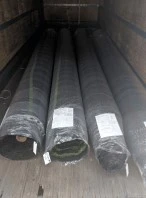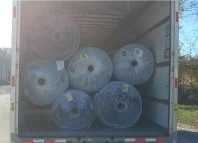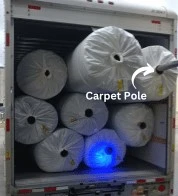How to Unload Turf from Truck: 7 Tips to a Smoother Turf Delivery

ATXTurf Delivery
On some artificial turf projects, removing the turf from the truck and transporting it to the installation site can be the biggest obstacle. In carpet mills, we use poles attached to forklifts to easily maneuver large rolls of turf, but customers don’t have these poles on the delivery end.
So, The ATXTurf team thought we would share some tips from our countless turf deliveries to make your turf delivery experience as seamless as an ATXTurf lawn installation.:)
If you are ordering turf online, and having it delivered to your business, school or residence, it will arrive inside a full-size, 48’ tractor trailer or a box truck, similar to a Uhaul truck, pictured here. The freight company will call to schedule a 24 hour advance appointment delivery. The driver will not help unload the turf and, most likely, will not pull up into your residential driveway.
If your delivery is later in the day, your rolls may be up in the nose of the truck and you’ll need 30 ft to 40 ft of strap to reach it inside a tractor trailer. If you are lucky, 
Tip #1: When the freight company calls to schedule the appointment delivery, ask them what size the delivery truck will be and where the turf will be located in it.
Tip #2: When the driver arrives, check his copy of the Bill of Lading before unloading anything to make sure it’s what you ordered. You know what’s a bigger pain than unloading a truck? Reloading the turf back onto it after realizing it’s not the right order.
Smaller Rolls Can Removed by Hand
Smaller rolls of turf, such as a 15 x 20 or 30s, can typically be dragged out of the truck by hand. These rolls typically weigh about 150 or 200 lbs. A padded turf will be heavier.
Tip #3: Wear gloves. The plastic packaging is often stapled to the cardboard cores inside the turf. Be very careful when grabbing the cardboard cores, as the large staples can become
Larger Rolls Will Have to be Dragged Out
Larger rolls, however, will require a lot of strong backs or some type of vehicle to unload. A 70 ft roll is typically about 18 to 22 inches in diameter and weighs ca. 500 lbs, while 200 ft rolls can be close to 4 FEET in diameter and weigh up to 2,000 lbs.
If the rolls are up in the nose of the truck, you’ll have to get up in the truck and drag the rolls out with a tow strap or rope tied to a tow hitch on the back of a pickup or SUV. A bobcat or forklift will also do the trick. Don’t worry if the roll falls to the ground. It’s not breakable.
Tow Straps or Rope
Freight companies usually call to schedule a 24 hour advance appointment delivery, so you’ve got time to run up to the hardware store and get a couple of tow straps or long rope, or go ahead and order it online.
Tip #4: We prefer the 30 ft tow straps with the loops on the end available at Home Depot. They are about $32.
How to Attach Strap to Turf Rolls
Slightly lift the end of the roll and slide the strap around the roll of turf about 4 ft from the end of the roll. This will give the strap enough room to tighten as you pull, before slipping off the

4, 15 x 45s of Turf
end and having to do it all over again.
Tip #5: The built-in loop on the strap makes it much easier to run the strap through, and will cinch tightly as you pull the roll, without having to tie and untie knots for each roll. Knots get super tight when you pull heavy rolls and nothing is more annoying than having a truck driver stare at you, while you spend 10 minutes trying to loosen a knot after moving each roll.
Where to Leave the Rolls of Turf
Keep in mind the truck driver is on a schedule and in a hurry. Many freight companies will even charge you a fee if you take longer than an hour to unload. If you are behind schedule, it might be best to just leave the rolls of turf where you pulled them off the truck, so the driver can get on his way, and out of your way. And yes, it’s OK to leave them out in the rain for a few days. It’s plastic wrapped in more plastic.
Tip #6: IF YOU HAVE TIME, it’s most efficient to take the rolls of turf to wherever they are going as you pull them off the truck. This prevents having to lift, strap and unstrap each roll all over again. Also, you may not have access to the tow hitch or forklift at another time.

Tip #7: If you have a lot of rolls and the building only has “people” doors, you might want to invest in a couple of dollies with wheels. Let the rolls fall onto the dollies when pulling it off the truck, then wheel it in through the door,(you’ll have to kick it a time or two to get it over the door threshold on the ground), push the roll off the dollies, then go back and drag the next roll off the truck onto the dollies and repeat.
Finally, after you have unloaded all the rolls of turf, the freight driver will have you sign the Bill of Lading. BEFORE SIGNING, count the rolls, inspect the rolls, read the labels on the rolls and compare it to the description on the Bill of Lading. If it all matches up, you are good to go. If something is off, tell the driver and make a note on the Bill of Lading.


0 Comments